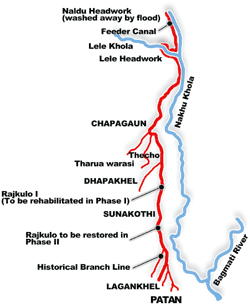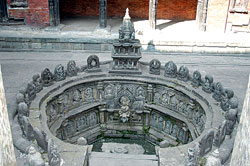 When the ancient Malla kings of Patan decided to build an elaborate canal system to bring water to their royal baths from 13 kms away, it must have been an undertaking like the Melamchi project is today.
When the ancient Malla kings of Patan decided to build an elaborate canal system to bring water to their royal baths from 13 kms away, it must have been an undertaking like the Melamchi project is today. Three hundred years ago the royal engineers diverted water from the Lele River at Tika Bhairab at the southern edge of the Valley, channelled the water along subterranean contour-hugging canals, across the outskirts, under the town all the way to the sunken spouts of the Darbar Square. They had to survey the gradient and precisely map the course of the canal.
Not much is known about how long it took to build, or even who constructed it-just the names of kings who not just took credit but also took baths in the water that came gushing out at the other end.
The most astounding thing about the Raj Kulo is that it also provided water for irrigation along the way and were working till as recently as the 1970s. Now, civil engineers who have studied them say that if revived the ancient royal canals of Patan and Bhaktapur could take care of the water needs of a considerable part of the Valley's population.
And that is exactly what the group, Environment and Heritage Conservation Nepal (EHCN), is trying to do with VDCs along the way and support from the Indian Government. Till the 1950s the Raj Kulo was maintained with support from the state but as the funding dried up so did the canals.
Houses and roads were built with scant attention to the canals underneath and within a few years the spouts at Darbar Square ran dry. In the past decade, urban expansion has taken its toll even on the southern suburbs of Patan. Engineers say that the Raj Kulos of Kathmandu and Bhaktapur are past rehabilitation but there is still hope to partially reconstruct the Patan canal.
 "It is a tribute to the people who built them that rehabilitating the canals will not only restore an ancient heritage but also take care of the water needs of the poorest of the poor," says Sagar Rana, president of EHCN, who is also the Nepali Congress representative from Lalitpur District.
"It is a tribute to the people who built them that rehabilitating the canals will not only restore an ancient heritage but also take care of the water needs of the poorest of the poor," says Sagar Rana, president of EHCN, who is also the Nepali Congress representative from Lalitpur District. The Patan Rajkulo used to be 11.2 kms from Tika Bhairab to Darbar Square but today it barely reaches Thecho, 5.6 kms away.
The Raj Kulos were not just water canals. They integrated water supply with irrigation: indicating the fine urban-rural balance of the Kathmandu Valley civilisation. The Raj Kulo irrigated rice fields along the way, traversed many towns filling up ponds and wells, they provide a constant flow of clean water to urban dwellers in Patan and helped sustain the ground water levels by recharging aquifers along the way.
"A revived Raj Kulo could be an immediate solution to the water scarcity problem the Valley faces every year," says water expert Prayag Raj Joshi who is involved in the rehabilitation project.
 Joshi says that when the work is finished in three years, the ancient royal canal will provide safe drinking water to 40,000 people in Patan and irrigate an additional 450 hectares of farms on the city's outskirts.
Joshi says that when the work is finished in three years, the ancient royal canal will provide safe drinking water to 40,000 people in Patan and irrigate an additional 450 hectares of farms on the city's outskirts. The Raj Kulo itself is 1.5 m wide and 1.3 m deep and in most places runs along the surface until it reaches town. In core city areas there is an ingenious underground aqueduct that takes the water to various water spouts.
The first phase of the rehabilitation program is underway now and covers 8.5 km of the canal from the source to the Sunakothi VDC passing through Chapagaon and Thecho. This includes rehabilitation of the upper stretches of the canal destroyed by the 1982 flash flood on the Lele River.
Santa Lal Maharjan, chairman of the Chapagaon User Committee thinks his community would not just benefit from the water but also learn more about Patan's history. "The Raj Kulo is such a big part of our tradition and day-to-day lives, we understand the benefits but we also understand how important it is to preserve what out forefathers accomplished," Maharjan told us.
Sagar Rana agrees: "The Raj Kulo is not just about water, it is about heritage and preserving the close-knit communities that the canal made possible during the time of our ancestors."


